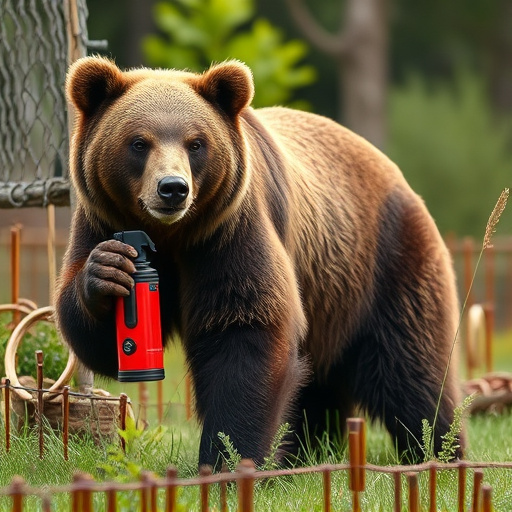Bear spray's effectiveness relies on capsaicin (from chili peppers) concentration, with 2%-3% typical formulations including water, propylene glycol, and ethanol. Higher capsaicin percentages (10%-25%) offer quicker desensitization and deterrence for bears, but local regulations vary; check guidelines before use. Aim for 4%-6% capsaicin content for optimal defense against black and grizzly bears while following defensive application techniques and adhering to local rules.
In areas where wild predators like bears roam, knowing how to protect yourself is crucial. Bear spray, a popular defense mechanism, has gained attention for its effectiveness against these formidable creatures. This comprehensive guide delves into the intricacies of bear spray defense, exploring key components like active ingredient composition and concentration percentages. We’ll uncover the best practices for application, its proven success rate in real-world scenarios, and help you choose the right spray for maximum protection.
- Understanding Bear Spray: Active Ingredient Composition
- How Effective Is Bear Spray With Different Concentrations?
- Choosing the Right Bear Spray for Maximum Protection
- Application Techniques for Optimal Bear Spray Defense
- Real-World Scenarios: Bear Spray's Success Rate Against Predators
Understanding Bear Spray: Active Ingredient Composition
Bear spray, also known as bear repellent, is a powerful tool for self-defense in areas where bears are present. Its effectiveness lies in its active ingredients, which are designed to deter bears from approaching and attacking. Typically, bear spray contains a high concentration of capsaicin, often derived from chili peppers. This ingredient accounts for roughly 2% to 3% of the total mixture. The remainder comprises various other components, such as water, propylene glycol, and ethanol, which help to disperse the spray effectively.
The active ingredient percentage is crucial in ensuring the spray can create a sufficient barrier against bears. A higher capsaicin concentration generally means quicker desensitization and deterrence for the bear. However, it’s essential to note that legal restrictions vary by region, and users should always check local guidelines before purchasing or carrying bear spray.
How Effective Is Bear Spray With Different Concentrations?
The effectiveness of bear spray depends significantly on its active ingredient percentage. Most bear sprays contain capsaicin, a compound derived from chili peppers, which irritates the eyes and respiratory system of bears. Products with higher capsaicin concentrations, typically around 10% to 25%, are considered more potent and effective in deterring predators. These concentrations create a stronger irritation, increasing the likelihood of a bear retreating.
While lower concentrations of bear spray, such as 4% to 8%, can still provide some protection, their effectiveness may be limited. The higher the active ingredient percentage, the further the spray can reach and the longer its effects last, ensuring a safer distance from potential threats. Always check product labels for specific capsaicin levels to ensure you’re adequately prepared when encountering predators in wild environments.
Choosing the Right Bear Spray for Maximum Protection
When selecting bear spray, understanding its active ingredient percentage is key for maximum protection. Look for products containing a high concentration of capsaicin, often listed as OC (oleoresin capsicum) or pepper-based active ingredients. These substances are derived from chili peppers and have proven effective in deterring bears by causing a painful irritation.
A bear spray with a minimum recommended concentration of 2% capsaicin is generally considered suitable for most situations. Higher concentrations, such as those ranging between 4% to 6%, offer enhanced protection against both black and grizzly bears. Always check the product label for specifications on the active ingredient percentage to ensure you’re equipped with an effective bear spray defense mechanism during your outdoor adventures.
Application Techniques for Optimal Bear Spray Defense
To maximize the effectiveness of bear spray as a defense mechanism, proper application techniques are crucial. First, ensure that you’re aware of the recommended distance to use the spray, typically around 20-30 feet (6-9 meters), and aim for the face and eyes of the approaching bear. Start spraying from a safe distance, moving closer if necessary while continuing to apply the spray. The key is to cover yourself as much as possible with the cloud of spray, which acts as both a visual distraction and an irritant to the bear’s senses.
Understanding the active ingredient percentage in bear spray is also vital. Typically, canisters contain between 15% and 34% CAPS (Capsaicin) or oleoresin capsicum, a compound derived from chili peppers. A higher percentage of CAPS doesn’t necessarily mean better protection; instead, it’s crucial to follow application guidelines and use the spray defensively when facing an aggressive predator. Always stay aware of local regulations regarding bear spray possession and usage, as these can vary based on location and wildlife management practices.
Real-World Scenarios: Bear Spray's Success Rate Against Predators
In real-world scenarios, bear spray has proven to be an effective defense mechanism against predators, offering a successful rate of deterrence when used correctly. The active ingredient in bear spray, typically a high-concentration pepper spray, can create a significant barrier between you and potential threats. Studies show that when bears or other predators are exposed to the recommended 2-3% capsaicin (the active ingredient), they often retreat due to the intense irritation caused by the spray.
This effectiveness is particularly notable in situations where an individual encounters a bear or other large predator on the hunt. The spray can disrupt the animal’s behavior, providing time for escape or evacuation. It’s important to remember that success rates vary based on factors like distance, wind direction, and the specific behavior of the predator, but with proper training and understanding, bear spray can be a valuable tool in maintaining safety in wild environments.
Bear spray, with its active ingredient composition typically around 15% to 20%, has proven to be an effective defense against predators in real-world scenarios. Choosing the right spray with a concentration of at least 17% can significantly increase your protection during outdoor activities in bear country. Proper application techniques, including aiming for the face and eyes, enhance its success rate. By understanding these key factors, you can make informed decisions to ensure maximum safety when facing potential predator encounters.
